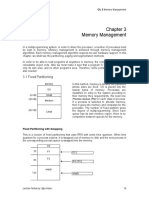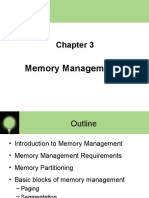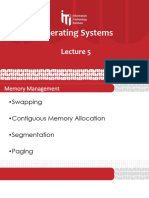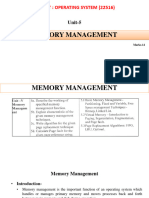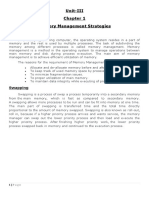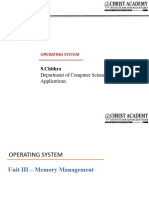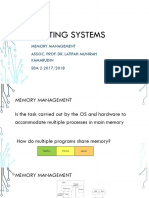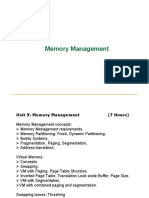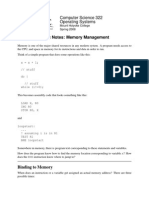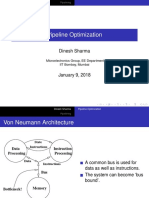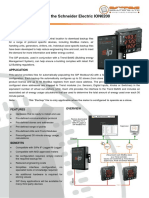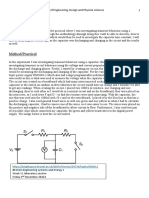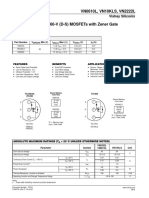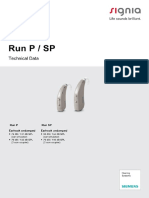Ch3 Memory Management
Uploaded by
valvi kuldipCh3 Memory Management
Uploaded by
valvi kuldipEE442 Operating Systems Ch.
3 Memory
Management
Chapter 3
Memory Management
In a multiprogramming system, in order to share the processor, a number of processes
must be kept in memory. Memory management is achieved through memory management
algorithms. Each memory management algorithm requires its own hardware support. In this
chapter, we shall see the partitioning, paging and segmentation methods.
In order to be able to load programs at anywhere in memory, the compiler must generate
relocatable object code. Also we must make it sure that a program in memory, addresses
only its own area, and no other program’s area. Therefore, some protection mechanism is
also needed.
3.1 Fixed Partitioning
Memory In this method, memory is divided into
partitions whose sizes are fixed. OS is placed
OS into the lowest bytes of memory. Processes
are classified on entry to the system according
(n KB) Small to their memory they requirements. We need
(3n KB) one Process Queue (PQ) for each class of
Medium process. If a process is selected to allocate
memory, then it goes into memory and
competes for the processor. The number of
(6n KB) fixed partition gives the degree of
Large
multiprogramming. Since each queue has its
own memory region, there is no competition
between queues for the memory.
Fixed Partitioning with Swapping
This is a version of fixed partitioning that uses RRS with some time quantum. When time
quantum for a process expires, it is swapped out of memory to disk and the next process in
the corresponding process queue is swapped into the memory.
OS
2K P3
P1
6K P2
P4 P5
12K empty
empty
Lecture Notes by Uğur 1
EE442 Operating Systems Ch. 3 Memory
Management
Normally, a process swapped out will eventually be swapped back into the same partition.
But this restriction can be relaxed with dynamic relocation.
In some cases, a process executing may request more memory than its partition size. Say
we have a 6 KB process running in 6 KB partition and it now requires a more memory of 1
KB. Then, the following policies are possible:
Return control to the user program. Let the program decide either quit or modify its
operation so that it can run (possibly slow) in less space.
Abort the process. (The user states the maximum amount of memory that the process
will need, so it is the user’s responsibility to stick to that limit)
If dynamic relocation is being used, swap the process out to the next largest PQ and
locate into that partition when its turn comes.
The main problem with the fixed partitioning method is how to determine the number of
partitions, and how to determine their sizes.
If a whole partition is currently not being used, then it is called an external fragmentation.
And if a partition is being used by a process requiring some memory smaller than the
partition size, then it is called an internal fragmentation.
OS In this composition of memory, if a
2K P1 (2K) new process, P3, requiring 8 KB of
6K External memory comes, although there is
Empty (6k) fragmentation enough total space in memory, it can
not be loaded because
12K P2 (9K) fragmentation.
Internal
Empty (3K) fragmentation
3.2 Variable Partitioning
With fixed partitions we have to deal with the problem of determining the number and sizes
of partitions to minimize internal and external fragmentation. If we use variable partitioning
instead, then partition sizes may vary dynamically.
In the variable partitioning method, we keep a table (linked list) indicating used/free areas
in memory. Initially, the whole memory is free and it is considered as one large block.
When a new process arrives, the OS searches for a block of free memory large enough for
that process. We keep the rest available (free) for the future processes. If a block becomes
free, then the OS tries to merge it with its neighbors if they are also free.
There are three algorithms for searching the list of free blocks for a specific amount of
memory.
First Fit : Allocate the first free block that is large enough for the new process. This is a fast
algorithm.
Lecture Notes by Uğur 2
EE442 Operating Systems Ch. 3 Memory
Management
Best Fit : Allocate the smallest block among those that are large enough for the new
process. In this method, the OS has to search the entire list, or it can keep it sorted and
stop when it hits an entry which has a size larger than the size of new process. This
algorithm produces the smallest left over block. However, it requires more time for
searching all the list or sorting it.
Worst Fit : Allocate the largest block among those that are large enough for the new
process. Again a search of the entire list or sorting it is needed. This algorithm produces
the largest over block.
Example 3.1
Consider the following memory map and assume a new process P4 comes with a memory
requirement of 3 KB. Locate this process.
OS
P1 a. First fit algorithm allocates from the 10 KB block.
<free> 10 KB b. Best fit algorithm allocates from the 4 KB block.
P2
c. Worst fit algorithm allocates from the 16 KB block.
<free> 16 KB
P3
<free> 4 KB
New memory arrangements with respect to each algorithms will be as follows:
First Fit Best Fit Worst Fit
OS OS OS
P1 P1 P1
P4 <free> 10 KB <free> 10 KB
At this point,
<free> if a new process, P2
7 KB P5 of 14K arrives, then itP2would wait if we used worst fit
algorithm,
P2 whereas it would be located
<free> in16
cases
KB of the others.
P4
<free> 16 KB P3 <free> 13 KB
Compaction:
P3 Compaction is a method
P4 to overcome the external
P3 fragmentation problem. All
free blocks KB brought together<free>
<free> 4are as one 1large
KB block of free space.
<free> Compaction requires
4 KB
dynamic relocation. Certainly, compaction has a cost and selection of an optimal
compaction strategy is difficult. One method for compaction is swapping out those
processes that are to be moved within the memory, and swapping them into different
memory locations.
OS
P1 OS
<free> 20 KB Compaction P1
P2 P2
<free> 7 KB P3
P3 <free> 37 KB
<free> 10 KB
Lecture Notes by Uğur 3
EE442 Operating Systems Ch. 3 Memory
Management
3.3 Paging
Paging permits a program to allocate noncontiguous blocks of memory. The OS divide
programs into pages which are blocks of small and fixed size. Then, it divides the physical
memory into frames which are blocks of size equal to page size. The OS uses a page table
to map program pages to memory frames. Page size (S) is defined by the hardware.
Generally page size is chosen as a power of 2 such as 512 words/page or 4096
words/page etc.
With this arrangement, the words in the program have an address called as logical
address. Every logical address is formed of
A page number p where p = logical address div S
An offset d where d = logical address mod S
When a logical address <p, d> is generated by the processor, first the frame number f
corresponding to page p is determined by using the page table and then the physical
address is calculated as (f*S+d) and the memory is accessed.
Logical memory Physical memory
The address page frame Attributes f0
P0 translation in paging is shown below
0 4
P1 1 3 P2 f1
2 1
P2 3 5 f2
Logical address Physical address
P3 Page Table P1 f3
p d f
P0 d
f4
P3 f5
d page frame Attributes d
p f
p f
Logical Memory Page Table Physical Memory
Lecture Notes by Uğur 4
EE442 Operating Systems Ch. 3 Memory
Management
Example 3.2
Consider the following information to form a physical memory
map. Page Size = 8 words
Physical Memory Size = 128 words
A program of 3 pages where P0 € f3; P1 € f6; P2 € f4
Logical Program Physical Memory
… …
Word 0
Word 1 Page 0 Word 0
… (P0) Page Table Word 1 Frame 3
Word … (f3)
7 Page Frame Word
Word 8 Page 0 3 7
Word 9 1 (P1) Word 16 Frame 4
1 6
Word 17 (f4)
… 2 4
Word 15 …
Word 16 Page 2 Word 23
Word 17 (P2) …
… …
Word 8 Frame 6
Word 9 (f6)
…
Word 15 …
Program Logical Offset Page Frame Physical
Line Address Number Number Address
Word 0 00 000 000 00 011 011 000
Word 1 00 001 001 00 011 011 001
… … … … … …
Word 7 00 111 111 00 011 011 111
Word 8 01 000 000 01 110 110 000
Word 9 01 001 001 01 110 110 001
… … … … … …
Word 15 01 111 111 01 110 110 111
Word 16 10 000 000 10 100 100 000
Word 17 10 001 001 10 100 100 001
…
Word 23 10 111 111 10 100 100 111
How to Implement The Page Table?
Every access to memory should go through the page table. Therefore, it must be
implemented in an efficient way.
a. Using fast dedicated registers
Keep page table in fast dedicated registers. Only the OS is able to modify these registers.
However, if the page table is large, this method becomes very expensive since requires too
many registers.
Lecture Notes by Uğur 5
EE442 Operating Systems Ch. 3 Memory
Management
Logical address
PTLR: Page Table Length Register
p d
Physical address
f d
YES Access
ratPT in Registers mat
Access
p<PTLR?
memory
ERROR
NO
Given a logical address to access the word in physical memory, first access the PT stored
in registers, which requires register access time (rat), and then find out the physical
address and access the physical memory, which requires memory access time (mat).
Therefore effective memory access time (emat) becomes:
emat= rat + mat
b. Keep the page table in main memory
In this method, the OS keeps a page table in the memory. But this is a time consuming
method. Because for every logical memory reference, two memory accesses are required:
1. To access the page table in the memory, in order to find the corresponding frame number.
2. To access the memory word in that frame
Logical address
PTBR: Page Table Base Register
p d
PTLR: Page Table Length Register
Physical address
f d mat
Access PT entry
in Memory at address PTBR + p Access
p<PTLR?
mat memory
. ERROR
NO
In this approach emat is:
emat= 2 * mat
Lecture Notes by Uğur 6
EE442 Operating Systems Ch. 3 Memory
Management
c. Use content-addressable associative registers
These are small, high speed registers built in a special way so that they permit an
associative search over their contents. That is, all registers may be searched in one
machine cycle simultaneously. However, associative registers are quite expensive. So, a
small number of them should be used.
Logical address
PTBR: Page Table Base Register
p d
PTLR: Page Table Length Register
Physical address
f d
YES Search PT in AR
p<PTLR? FOUND?
YES (hit)
rat
NO
NO (miss) Physical address
f d
ERRO Access PT entry Access memory
in Memory at address PTBR + p
mat
mat
When a logical memory reference is made, first the corresponding page number is
searched in associative registers. If that page number is found in one associative register
(hit) then the corresponding frame number is get, else (miss) the page table in memory is
accessed to find the frame number and that <page number, frame number> pair is stored
into associative registers. Once the frame number is obtained, the memory word is
accessed.
The hit ratio is defined as the percentage of times that a page number is found in
associative registers. Hit ratio is important in performance of the system since it affects the
effective memory access time. In the case of finding the page number in associative
registers, only one memory access time is required whereas if it cannot be found two
memory accesses are needed. So, greater the hit ratio, smaller the effective memory
access time. Effective memory access time is calculated as fallows:
emat= h *ematHIT + (1-h) * ematMISS
where
h = The hit ratio
ematHIT = effective memory access time when there is a hit = rat + mat
ematMISS = effective memory access time when there is a miss = rat + mat + mat
Lecture Notes by Uğur 7
EE442 Operating Systems Ch. 3 Memory
Management
Example 3.3
Assume we have a paging system which uses associative registers. These associative
registers have an access time of 30 ns, and the memory access time is 470 ns. The system
has a hit ratio of 90 %.
Now, if the page number is found in one of the associative registers, then the effective
access time:
ematHIT = 30 + 470 = 500 ns.
Because one access to associative registers and one access to the main memory is
sufficient.
On the other hand, if the page number is not found in associative registers, then the
effective access time:
ematMISS = 30 + (2 * 470) = 970 ns.
Since one access to associative registers and two accesses to the main memory iare
required.
Then, the emat is calculated as follows:
emat = 0.9 * 500 + 0.1 * 970
= 450 + 97 = 547 ns
Sharing Pages
Sharing pages is possible in a paging system, and is an important advantage of paging. It
is possible to share system procedures or programs, user procedures or programs, and
possibly data area. Sharing pages is especially advantageous in time-sharing systems. A
reentrant program (non-self-modifying code = read only) never changes during execution.
So, more than one process can execute the same code at the same time. Each process
will have its own data storage and its own copy of registers to hold the data for its own
execution of the shared program.
Example 3.4
Consider a system having page size=30 MB. There are 3 users executing an editor
program which is 90 MB (3 pages) in size, with a 30 MB (1 page) data space.
To support these 3 users, the OS must allocate 3 * (90+30) = 360 MB space. However, if
the editor program is reentrant (non-self-modifying code = read only), then it can be shared
among the users, and only one copy of the editor program is sufficient. Therefore, only 90 +
30 * 3 = 180 MB of memory space is enough for this case.
Lecture Notes by Uğur 8
EE442 Operating Systems Ch. 3 Memory
Management
User-1 PT-1 Physical
P0 e1 Page# Frame# Memory
P1 e2 0 8 f0
P2 e3 1 4 f1
P3 data1 2 5 f2
3 7 f3
f4 e2
User-2 PT-2 f5 e3
P0 e1 Page# Frame# f6
P1 e2 0 8 f7 data1
P2 e3 1 4 f8 e1
P3 data2 2 5 f9
3 12 f10 data3
f11
User-3 PT-3 f12 data 2
P0 e1 Page# Frame# f13
P1 e2 0 8 f14
P2 e3 1 4 f15
P3 data3 2 5
3 10
3.2 Segmentation
In segmentation, programs are divided into variable size segments, instead of fixed size
pages. Every logical address is formed of a segment name and an offset within that
segment. In practice, segments are numbered. Programs are segmented automatically by
the compiler or assembler.
For example, a C compiler will create separate segments for:
1. the code of each function
2. the local variables for each function
3. the global variables.
Main
Func 1 Func 2
Data 1
Data 1
Data 3
Lecture Notes by Uğur 9
EE442 Operating Systems Ch. 3 Memory
Management
For logical to physical address mapping, a segment table is used. When a logical address
<s, d> is generated by the processor:
1. Base and limit values corresponding to segment s are determined using the
segment table
2. The OS checks whether d is in the limit. (0 d < limit)
3. If so, then the physical address is calculated as (base + d), and the memory is
accessed.
logical address
s d
base
d
acess the word at physical address =Segment
base + dS
YES
0 d < limit
Seg. # Limit base Attr.
NO
ERROR
Example 3.5
Generate the memory map according to the given segment table. Assume the
generated logical address is <1,123>; find the corresponding physical address.
physical
Segment Limit Base memory
0 1500 1000 0
1 200 5500
2 700 6000 1000
3 2000 3500 s0
2500
3500
Now, check segment table entry for segment 1. s3
The limit for segment 1 is 200. Since 123 < 200,
we carry on. The physical address is calculated s1 5500
as 5500 + 123 = 5623, and the memory word 5700
5623 is accessed. s2 6000
6700
Segment tables are also implemented in the main memory or in associative registers, in
the same way it is done for page tables.
Lecture Notes by Uğur 1
EE442 Operating Systems Ch. 3 Memory
Management
Sharing Segments
Also sharing of segments is applicable as in paging. Shared segments should be read
only and should be assigned the same segment number.
Example 3.6:
Consider a system in which 3 users executing an editor program which is 1500 KB in size,
each having their own data space.
user-1 ST-1
seg lim base
editor 0 1500 1000
1 2000 3500 physical
memory
data-1
0
1000
editor
user-2 2500
ST-2
3500
seg lim base data-1
editor
data-2 0 1500 100
1 200 5500 data-2 5500
5700
data-3 6000
user-3
6700
ST-3
editor seg lim base
0 1500 100
1 700 6000
data-3
Lecture Notes by Uğur 1
EE442 Operating Systems Ch. 3 Memory
Management
3.3. Paged segmentation
The idea is to page the segments and eliminate the external fragmentation problem. In
paged segmentation the logical address is made of <s,p,d> triplet. The ST entry for
segment S now, contains:
the length of segment S
the base address of the PT for segment S.
There is a separate PT for every segment. On the average, now there is half a page of
internal fragmentation per segment. However, more table space is needed. In the worst
case, again three memory accesses are needed for each memory reference.
The flowchart for accessing a word with logical address <s,p,d> is shown below.
s pd 0 pd limit p d PT for
segment S
ST
NO
STBR
+ limit base
ERROR f
+
f d
STBR: Segment Table Base Register d
f
QUESTIONS
1. Why do we need memory management and CPU scheduling algorithms for a multiuser
system ? Can we do without these algorithms? Explain briefly.
2. a. Explain the terms: internal fragmentation and external fragmentation.
b. List the memory management methods discussed, and indicate the types of
fragmentation caused by each method.
Lecture Notes by Uğur 1
EE442 Operating Systems Ch. 3 Memory
Management
3. Consider a multiuser computer system which uses paging. The system has four
associative registers. the content of these registers and page table for user_12 are given
below:
Page table for user_12 associative registers
0 9 PTBR[12]:50000
PTLR[12]:5 user # page # frame #
1 6 :1024 words
PAGE SIZE 12 3 7
2 15 5 2 18
3 7 12 4 42
4 42 9 0 10
For the following logical addresses generated by user_12's program, calculate the physical
addresses, explain how those physical addresses are found, and state the number of
physical memory accesses needed to find the corresponding word in memory. If a given
logical address is invalid, explain the reason.
i. <2,1256> ii. <3,290>
iii. <4,572> iv. <5,290>
v. <0,14>
4. The following memory map is given for a computer system with variable partitioning
memory management.
0 Job Requested memory
J1 (50K)
1) J4 arrives 10K
free (45K) 2) J5 arrives 20K
3) J6 arrives 15K
J2 (40K) 4) J7 arrives 20K
free (10K) 5) J3 leaves
J3 (20K) 6) J8 arrives 50K
free (30K)
Find and draw the resulting memory maps, after each step of the above job sequence is
processed, for :
a. first-fit b. best-fit c. worst-fit
5. Consider a computer system which uses paging. Assume that the system also has
associative registers.
a. Explain how logical addresses are translated to physical addresses.
Lecture Notes by Uğur 1
EE442 Operating Systems Ch. 3 Memory
Management
b. Calculate the effective memory access time given:
assoc. register access time = 50 nanosec.
memory access time = 250
nanosec.
hit ratio = 80%
c. With the above associative register and memory access times, calculate the minimum hit
ratio to give an effective memory access time less than 320 nanoseconds.
6. A system which utilizes segmentation gives you the ability to share segments. If the
segment numbers are fixed, then a shared segment table is needed, and the ST must be
modified. We shall assume that the system is capable of dynamic relocation, but to reduce
the overhead, we want to avoid it unless it is absolutely necessary. The following example
is given for such a system :
ST-6 ST-9s#
s# base size shares base size shares
0 - - 256 0 190 100 -
1 0 100 - 1 - - 256
2 100 90 - 2 290 10 -
3 600 15 -
SST
s# base size no. of sh.
256 400 200 2
Assume maximum number of segments per process is 256, and segments are numbered
starting with 0.
a. What would be done when a segment previously unshared, becomes a shared segment?
b. When do we need dynamic relocation in this system?
c. Assume segment-2 of process 6 is being executed. A reference is made to segment-0 of
process 6. How is the corresponding physical address going to be found?
d. How would self-references within shared segments be handled?
e. What is the no. of sharers field in SST used for?
7. In the X-2700 computer, logical addresses are 24 bits long. The machine implements
paged segmentation with a maximum segment size of 64K words and 4K-word pages:
a. Show the logical address structure indicating the segment, page and displacement bits.
b. How many segments can a user process contain?
c. If a process has to be fully loaded into memory to execute, what is the minimum physical
memory capacity?
d. If the memory unit contains 65536 frames, show the physical address structure.
Lecture Notes by Uğur 1
EE442 Operating Systems Ch. 3 Memory
Management
e. Show the functional block structure of a suitable architecture for implementing paged
segmentation in the X-2700. Indicate the sizes of all necessary tables.
8. Given the memory map in the figure, where areas not shaded indicate free regions,
assume that the following events occur:
Step event required contiguous P1
memory size (K)
<free> 30 K
i) process 5 arrives 16
ii) process 6 arrives 40 P2
iii) process 7 arrives 20
<free> 20 K
iv) process 8 arrives 14
v) process 5 leaves - P3
vi) process 9 arrives 30
<free> 50 K
P4
1) Draw the memory maps after step (iv) and (vi) using first fit, best-fit and worst-fit
allocation techniques, without compaction
2) Draw the same memory maps as in part (a) if compaction is performed whenever
required. Also show the maps after each compaction.
9. In a paging system , the logical address is formed of 20 bits. the most significant 8 bits
denote the page number, the least significant 12 bits denote the offset. Memory size is
256K bits.
a. What is the page size (in bits)?
b. What is the maximum number of pages per process?
c. How many frames does this system have?
d. Give the structure of the page table of a process executing in this system. Assume 2 bits
are reserved for attributes.
e. How many bits are required for each page table entry?
f. If physical memory is upgraded to 1024 K bits, how will your answer to c and e change?
10. Consider a segmentation system with the following data
given: STBR=1000
STLR=5
Associative Registers access time = 50 nsec
Memory Access time = 500 nsec
Lecture Notes by Uğur 1
EE442 Operating Systems Ch. 3 Memory
s# Management
ST AR
s# base limit base limit
0 10000 1000 0 10000 1000
1 12000 2000 1 12000 2000
2 25000 4000
3 15000 8000
4 38000 4000
Assume data can be written into associative registers in parallel with a memory read or
write operation. For replacement of data in associative registers, LRU policy is used.
For each of the following logical addresses, find the corresponding physical address to be
accessed, and the total execution time required for that access, including the time spent for
address translation operations. Also indicate which memory locations are accessed during
address translation. Clearly show all changes made in associative registers.
a. <0,150> b. <0,3700> c. <2,900>
d. <2,3780> e. <5,200> f. <1,200>
11.
P1
Consider the memory map given in the figure. If worst fit
policy is to be applied, then what will be the memory map
<free> 9K after arrival of the processes
P2 P5=3K, P6=5K, P7=7K P8=6K.
<free> 20 K
Indicate if compaction is needed.
P3
<free> 14 K
P4
12. The following memory map is given for a computer system with variable partitioning
memory management.
P1 9K event required contiguous memory size (K)
i) P4 arrives 16
<free> 20 K ii) P5 arrives 40
iii) P6 arrives 20
P2 11K iv) P7 arrives 14
<free> 10 K
Find and draw the resulting memory maps after the above job
P3 18K sequence is processed completely for
<free> 30 K 1) first fit b. best fit c. worst fit
indicating whenever a compaction is needed.
Lecture Notes by Uğur 1
You might also like
- Week 8 - Memory Management (Early Systems)No ratings yetWeek 8 - Memory Management (Early Systems)57 pages
- Module-4 MEMORY MANAGEMENT: Memory-Management Strategies, Virtual-Memory ManagementNo ratings yetModule-4 MEMORY MANAGEMENT: Memory-Management Strategies, Virtual-Memory Management35 pages
- Operating Systems (CS/CPE 408) : Memory ManagementNo ratings yetOperating Systems (CS/CPE 408) : Memory Management8 pages
- UNIT-IV Memory-Management-in-Operating-SystemsNo ratings yetUNIT-IV Memory-Management-in-Operating-Systems30 pages
- Operating Systems: Memory Management (Chapter 8: 8.1-8.6)No ratings yetOperating Systems: Memory Management (Chapter 8: 8.1-8.6)48 pages
- Operating Systems: Memory Management Assoc. Prof. Dr. Latifah Munirah Kamarudin SEM 2 2017/2018No ratings yetOperating Systems: Memory Management Assoc. Prof. Dr. Latifah Munirah Kamarudin SEM 2 2017/201840 pages
- Topic Notes: Memory Management: Computer Science 322 Operating SystemsNo ratings yetTopic Notes: Memory Management: Computer Science 322 Operating Systems25 pages
- OSY Notes Vol 2 (5th Chapter) - Ur Engineering FriendNo ratings yetOSY Notes Vol 2 (5th Chapter) - Ur Engineering Friend14 pages
- Wireless Power Transmission Using MicrowavesNo ratings yetWireless Power Transmission Using Microwaves10 pages
- An Introduction To NFS: Derived From An Article by Frederic Ranal and A Presentation by Chavalit SrisathapornphatNo ratings yetAn Introduction To NFS: Derived From An Article by Frederic Ranal and A Presentation by Chavalit Srisathapornphat39 pages
- Lis of LAB EXPERIMENTS With CLOs and Performance RubricsNo ratings yetLis of LAB EXPERIMENTS With CLOs and Performance Rubrics1 page
- SIP Easy For The Schneider PowerLogic ION6200No ratings yetSIP Easy For The Schneider PowerLogic ION62002 pages
- 1SFA898120R7000 pstx1050 600 70 SoftstarterNo ratings yet1SFA898120R7000 pstx1050 600 70 Softstarter2 pages
- VN0610L, VN10KLS, VN2222L: Vishay SiliconixNo ratings yetVN0610L, VN10KLS, VN2222L: Vishay Siliconix4 pages
- Pulse Amplitude Modulation and Demodulation Aim0% (1)Pulse Amplitude Modulation and Demodulation Aim3 pages
- SAP Basis Administrator Problems and SolutionsNo ratings yetSAP Basis Administrator Problems and Solutions4 pages

